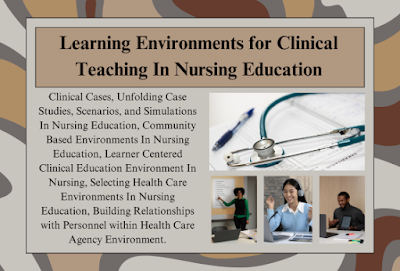Clinical teaching and learning environments are important components of nursing education. They provide students with practical experience, develop skills, and integrate theory and practice.
The Learning Environments for Clinical Teaching In Nursing Education
These facilities encompass various healthcare sectors, including hospitals, clinics, and other primary care settings. Effective clinical learning environments foster supportive relationships between students and faculty, provide diverse learning opportunities, and create a climate that promotes professional development. Learning Environments for Clinical Teaching The clinical teaching environment in nursing education plays a crucial role in shaping future nurses’ competencies, skills, and professional behavior.
It encompasses various settings, teaching methods, and interactions that impact student learning outcomes. This article discusses key areas in clinical teaching, including clinical cases, unfolding case studies, community-based environments, learner-centered education, selecting healthcare environments, and building relationships within healthcare agencies.
1. Clinical Cases, Unfolding Case Studies, Scenarios, and Simulations in Nursing Education
Simulated experiences are vital in helping students integrate psychomotor skills, critical thinking, and clinical reasoning. These simulations allow students to evaluate their actions and assess their ability to apply theoretical knowledge to practice. High-fidelity human patient simulators (HPS) provide realistic scenarios that substitute for unpredictable clinical experiences, making them invaluable for preparing students for real-world practice.
The use of HPS not only helps bridge the transition from classroom to practicum but also enhances patient care and safety. Students can practice skills in a risk-free environment, receive immediate feedback, and engage in interactive learning. While low-fidelity strategies like case studies and scenarios are also effective, they serve as foundational tools that bridge the gap between theory and practice.
2. Community-Based Environments in Nursing Education
The shift in healthcare from hospital settings to outpatient and community-based care has significantly influenced nursing education. With the advent of the Patient Protection and Affordable Care Act (PPACA), more nurses are required to practice in settings like home health agencies, long-term care facilities, and community clinics. Faculty must adapt clinical placements to ensure students meet learning objectives in these environments.
The use of technology, such as video conferencing and remote communication tools, facilitates clinical learning in community settings. However, the challenge remains in finding appropriate learning experiences and overcoming economic and staffing constraints. Despite these difficulties, community-based environments provide opportunities for students to develop critical thinking, communication, and system understanding skills. Faculty can supplement these experiences with simulations to enhance skill proficiency.
3. Learner-Centered Clinical Education Environments
The culture within healthcare environments, including specific units, profoundly impacts teaching and learning. Factors like staffing levels, patient acuity, and the behavior of healthcare professionals shape the learning experience. Negative aspects such as lateral violence—verbal aggression between staff members—are often observed by students, affecting their learning.
Faculty play a critical role in guiding students through these environments by holding debriefing sessions, listening to students’ perceptions, and providing strategies to mitigate the impact of negative experiences. This learner-centered approach ensures that students can process their emotions and continue to learn effectively.
4. Selecting Health Care Environments for Nursing Education
Faculty are responsible for choosing appropriate clinical learning environments (CLEs) that align with the nursing curriculum. Factors such as accreditation status, staff adequacy, patient population, and physical resources must be considered. Challenges such as rapid patient turnover and limited patient availability may hinder optimal clinical experiences, requiring faculty to use creative teaching methods to achieve learning outcomes.
Faculty should focus on connecting classroom content with clinical practice to develop students’ critical thinking and clinical reasoning skills. Dual assignments, where faculty teach both in the classroom and clinical settings, can help bridge these connections.
5. Building Relationships with Personnel in Healthcare Agencies
Strong relationships between clinical faculty and healthcare staff are essential for effective student learning. These relationships depend on clear communication about goals, competencies, and expectations. Faculty must understand the clinical environment, adapt teaching methods accordingly, and engage staff in the learning process.
Orientation to the practicum environment and early student-staff engagement help establish positive interactions and clarify roles. By demonstrating respect for the mission and values of the agency, faculty foster a supportive environment where students can thrive.
Conclusion
Nursing education relies on well-structured clinical teaching environments to produce competent and confident nurses. By utilizing various learning strategies, adapting to community-based settings, fostering learner-centered environments, selecting appropriate CLEs, and building strong relationships within healthcare agencies, educators can provide students with a comprehensive and enriching educational experience.
Read More:
https://nurseseducator.com/didactic-and-dialectic-teaching-rationale-for-team-based-learning/
https://nurseseducator.com/high-fidelity-simulation-use-in-nursing-education/
First NCLEX Exam Center In Pakistan From Lahore (Mall of Lahore) to the Global Nursing
Categories of Journals: W, X, Y and Z Category Journal In Nursing Education
AI in Healthcare Content Creation: A Double-Edged Sword and Scary
Social Links:
https://www.facebook.com/nurseseducator/
https://www.instagram.com/nurseseducator/
https://www.pinterest.com/NursesEducator/
https://www.linkedin.com/in/nurseseducator/
https://www.researchgate.net/profile/Afza-Lal-Din
https://scholar.google.com/citations?hl=en&user=F0XY9vQAAAAJ
